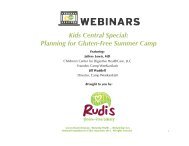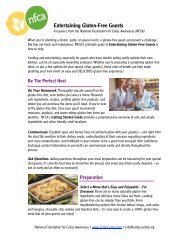504 Plan Roadmap - National Foundation for Celiac Awareness
504 Plan Roadmap - National Foundation for Celiac Awareness
504 Plan Roadmap - National Foundation for Celiac Awareness
You also want an ePaper? Increase the reach of your titles
YUMPU automatically turns print PDFs into web optimized ePapers that Google loves.
What is the treatment<br />
The only treatment <strong>for</strong> celiac disease is a 100%, life-long gluten-free diet, which means<br />
avoiding all <strong>for</strong>ms of wheat, barley and rye. A special caution must be given to oats, which in<br />
their natural <strong>for</strong>m do not contain the gluten protein. However, most fields where oats are grown<br />
and mills that produce and store oats also manufacture wheat, barley or rye, resulting in crosscontamination.<br />
Current research shows that the majority of patients with celiac disease can<br />
tolerate oats in their pure, uncontaminated <strong>for</strong>m. It is important that oat consumption be<br />
limited to oats with one of the following labels: “pure, uncontaminated oats, ” “gluten-free, ” or<br />
“certified gluten-free oats.” It is recommended that oats be introduced under medical<br />
supervision and slowly.<br />
Despite these restrictions, people with celiac disease can eat a well-balanced diet that consists<br />
of healthy and delicious foods. Even though it may seem impossible to maintain the diet at<br />
school, these simple guidelines will ensure that your child has the best possible experience<br />
throughout their school years.<br />
OVERVIEW OF THE CHILD’S CONDITION<br />
• History of celiac disease of child:<br />
o Year of diagnosis<br />
o Amount of time on a gluten-free diet<br />
• Basis <strong>for</strong> the determination of the disability:<br />
o Refer to letter from doctor/physician initiating <strong>504</strong> plan<br />
• Disability that affects a major life activity:<br />
o Restricted diet, gluten-free<br />
• Child’s developmental level and needs:<br />
o Self-reliance <strong>for</strong> the student in managing their diet and disease. This fluctuates<br />
individually and developmentally. Some indicators of a child’s readiness: The<br />
student is always able to visually recognize the allergen in all its hidden <strong>for</strong>ms or<br />
part of another food (starch, malt, play dough, etc.).<br />
__________Yes _____________No<br />
o The student is always able to read labels <strong>for</strong> gluten.<br />
__________Yes _____________No<br />
o The student is always able to verbally communicate body discom<strong>for</strong>t associated<br />
with a reaction. __________Yes _____________No<br />
o The student always knows to wash his/her hands well with an approved soap and<br />
warm water be<strong>for</strong>e eating. __________Yes _____________No<br />
o The student always knows to eat only food brought from home. (If arranged)<br />
__________Yes _____________No<br />
<strong>National</strong> <strong>Foundation</strong> <strong>for</strong> <strong>Celiac</strong> <strong>Awareness</strong> ⎢P.O. Box 544, Ambler, PA 19002<br />
215‐325‐1306 ⎢ www.<strong>Celiac</strong>Central.org ⎢ info@celiaccentral.org






